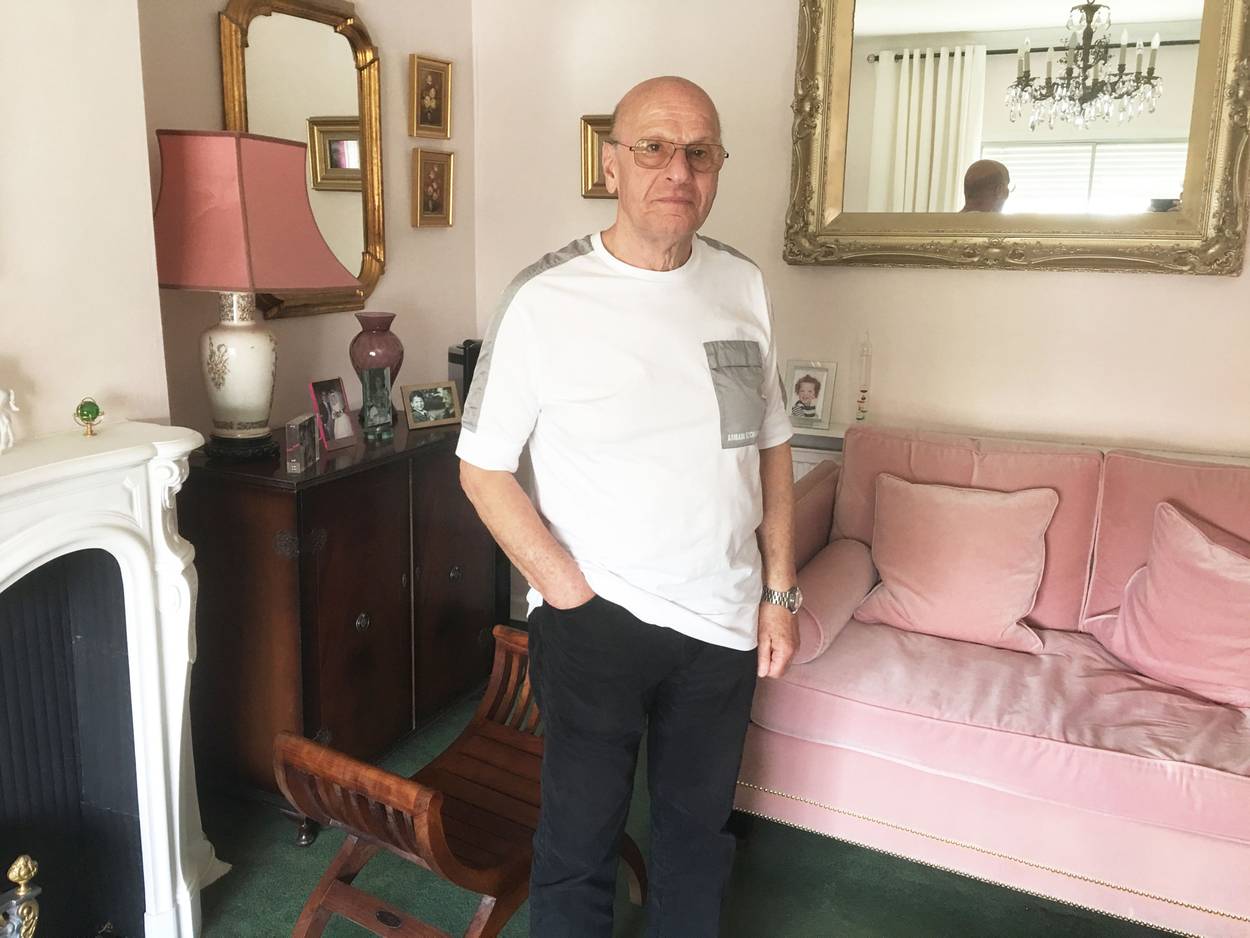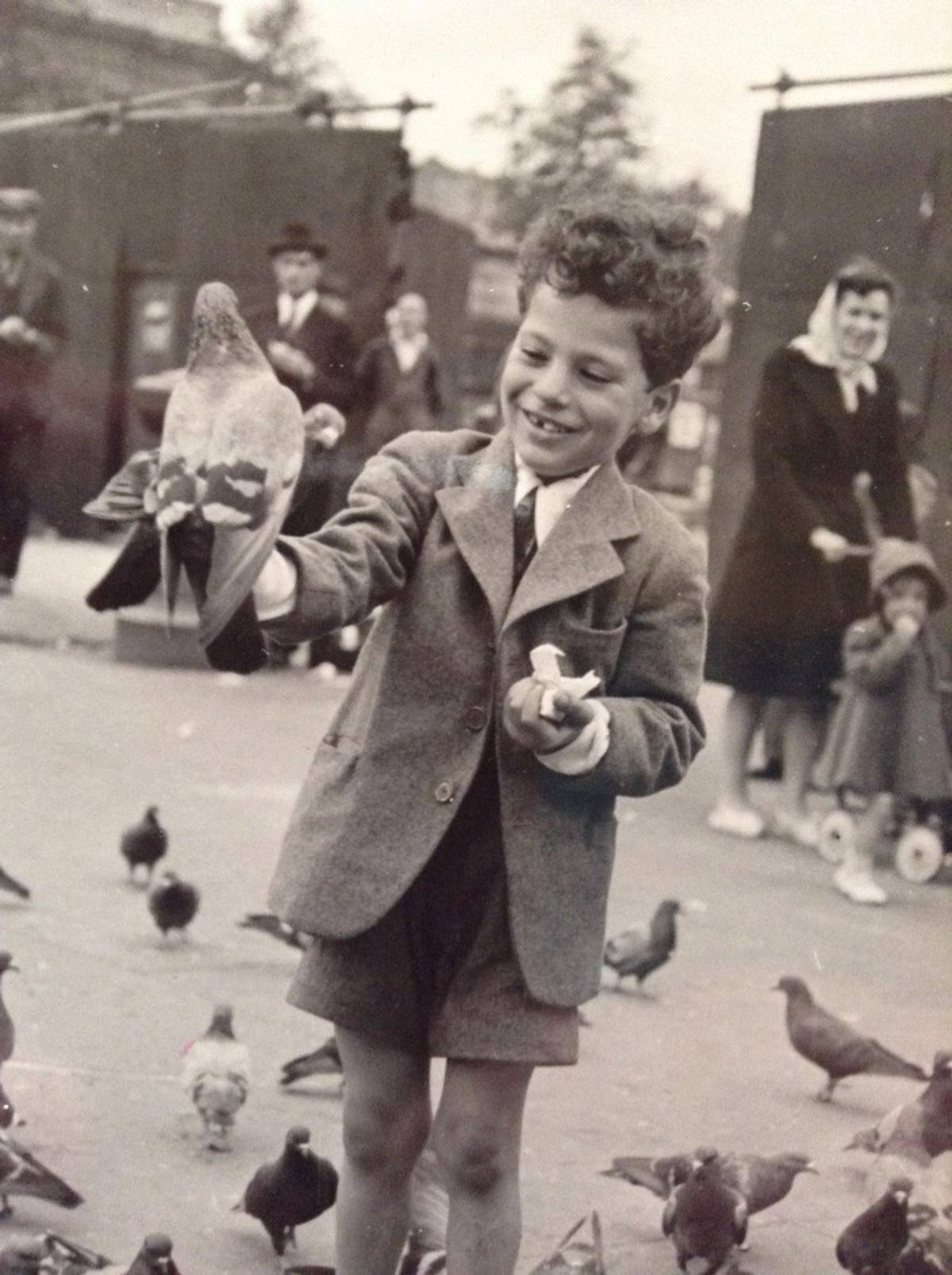A London Cabbie’s Holocaust
Taxi driver Jackie Young found out he wasn’t who he thought he was




Jackie Young has spent his adult life trying to discover the story of his life; each tiny fact is part of the giant puzzle he is still piecing together. A piece of that puzzle can be found here, in a house on the Sussex Downs. “This is it! I knew I could find it,” he says, as we arrive in the driveway. He jumps out of the car and strides up to the front door. “This is Bulldog’s Bank,” he announces, adding apprehensively, “Let’s hope there is someone in!”
Standing under a pretty pink climbing rose, Young explains that when he was 4 years old he was one of six children brought to the house by the psychologist Anna Freud, the daughter of Sigmund Freud. The children, who were among the youngest survivors of the Theresienstadt ghetto, were part of a group of 300 child Holocaust survivors brought from Prague by the Central British Fund for German Jewry, the organization that had organized the prewar Kindertransports.
A middle-aged couple, Hamish and Janey Mykura, open the door. Fortunately, the Mykuras know the story and welcome Young and his wife, Lita, inside. This is the first time he has been inside the house since he was a child. They step into the hallway where Freud recorded that Young used to play with his train set. Hamish Mykura, to Young’s surprise, tells him that his father was a prewar political refugee from Czechoslovakia.
Bulldog’s Bank stands on a ridge above a valley. A heritage steam train chuffs along in the distance. “As a child I had recurring dreams of green hills and pretty lights, like stars on the ground. There it is down there,” says Young standing on the lawn at the back of the house. He remembers a swing that is long gone that stood in the corner of the garden.

Everything else Jackie Young knows about his early childhood comes from accounts written by Anna Freud and the sisters Sophie and Gertrude Dann, two prewar refugees from Germany who helped run the home. Anna Freud and her family had been forced to leave Vienna in 1938. In London, she worked at the Hampstead War Nursery, which cared for children whose lives had been affected by bombing raids and developed her interest in the impact of conflict on children. Observing the six tiny Holocaust survivors was an unparalleled opportunity for the founder of psychoanalytic child psychology.
Janey Mykura shows Young the terrace where, on warm days, the children were served meals. They only ate when everyone had checked they had all been served equal portions. Freud said that the children showed a unique solidarity.
Young tells the Mykuras that they were frightened of dogs, trucks, and feathers. He talks of the other children as if they were siblings. “We spoke a bit of Czech and a bit of German but within a year we only spoke English.”
Young was adopted by a Jewish couple from North London who never spoke about his past. But, when he was 9, he discovered he was adopted. It did not matter, until, when he was a teenager, his grandmother told him he was born in Austria. Confused, Young rushed home to ask his parents if it was true. His father lost his temper and stormed out of the room.
“They lavished on me whatever I wanted but if I wanted to know about my past it was like a bigger wall than the Berlin Wall. It was a no-go area,” he says. “I was too nervous to ask more.”
When Young was 19 years old, he met Lita. To marry in the synagogue, he had to show documents proving he was Jewish. “My mother kept the papers in a safe deposit box so no one could see them but she had to show them to the officials.” As the secretary handed them back to her, Young snatched them out of his hand.
“With utter astonishment I saw that I had been in a concentration camp,” he recalls. “My real name was Jona Speigel and my mother had been Elsa Speigel, born in 1909 in Vienna. We all stood there dumbfounded, and I was hysterical.”

His adoptive mother still refused to speak, so Young and his fiancée went to the United Restitution Organization, a legal aid service for survivors, to try to find out more about his past. They discovered that his mother, a milliner, had left Young in an orphanage three months before she was deported to Minsk. Young was just 9 months old when he was sent to Theresienstadt in 1942. Years later he found out that “to save my feelings the organization didn’t mention she was unmarried.”
As a young newlywed, Young tried to put the past behind him until he saw an exhibition at Swiss Cottage Library of children’s drawings from Theresienstadt. “I discovered that of the 15,000 children who were in the ghetto only 100 survived,” he says. He then traveled to Vienna. “I stood outside a large block of flats where my mother had lived and felt miserable. It felt completely alien and I simply left.”
Back home in his North London kitchen, Young explains over tea that his adoptive mother had refused to have any communication with the Central British Fund after the adoption. He now knows that his mother had a brother and a married sister. The latter left Austria for Yugoslavia in 1939. “Maybe she tried to look for me, who knows?” he says clearly frustrated.
Young spent a year at Bulldog’s Bank before being moved to another nearby children’s hostel run by the German Jewish refugee and relief worker Alice Goldberger. She was in charge of his adoption. In 1978, the TV show This Is Your Life decided to profile her, and the Dann sisters wrote to Young’s adoptive mother hoping he could appear on the show. “She kept the letters for three months and then one day came to our flat and threw them at Jackie” says Lita.
The couple decided to meet the sisters despite his mother’s disapproval. “It was so strange. They mentioned peoples’ names, but we didn’t have a clue who they were talking about,” recalls Lita who has supported her husband on every step of his journey.
The sisters did not mention the TV show for fear of upsetting Young’s adoptive mother. Young, however, saw the show and immediately recognized Goldberger as the elderly lady who had often smiled at him on the bus when he was a child. “I could not believe that she had lived down the road from me all those years and never said a word because my mother had insisted that was how it was to be.” Young has papers showing Goldberger considered stopping his adoption at the last minute but was fearful of the damage another separation would have on him.
The 300 children who arrived in the United Kingdom with Young have become known as “The Boys,” and are regarded as a tightknit group of friends. Young, however, says the Bulldog’s Bank children never gelled with the larger group. “They were older and always looked down us because we could not remember and had spent the war in Theresienstadt,” he says. “They have memories I have been deprived of. I am void of memories and that makes me lucky and unlucky. I would love to have had memories. Nor was Theresienstadt a walk in the park. 33,000 people died there. I was there two years and lost my family. Yes, I had a good time. Thanks.”
Being a Holocaust survivor but having no recollection is an almost unique challenge. “Sometimes you think the whole thing is made up. I used to approach elderly Viennese Jews I saw in the local park and ask them to tell me what they knew but they said nothing. I even met Willy Groag, one of the people who cared for us in Theresienstadt, who simply said no children survived.” In fact, Groag had signed the papers relating to the children’s emigration to the United Kingdom.
Those papers show that the children were supposed to be in transit for Palestine. Young has not seen these papers before. The 100 children who survived Theresienstadt were immediately taken into the care of the Czech Christian pacifist Premysl Pitter.
Pitter was a committed Zionist, but also believed that the child survivors would be happier if they were brought up together by adults who had had similar experiences. Indeed, many of the children who were not sent to the United Kingdom grew up together on a kibbutz in Israel. But when Young and the other tiny survivors arrived in the United Kingdom, Pitter’s wishes were ignored. The British government was keen to limit immigration into the Palestine Mandate for fear of Arab reprisals and the Central British Fund was also short of money to pay for the children’s care. Bulldog’s Bank was funded by the U.S. Foster Parents Plan, which hoped to resettle the children in America.
Young does not dwell on what might have been. He quickly moves on to show the pictures of Bulldog’s Bank as you would snaps from a family photo album. In 1982, a psychologist, Sarah Moskovitz, reunited the six children for the first time. “I like to keep in touch with them occasionally, knowing they share the same pain as myself, but that is as far as it goes,” he says. “It can be a bit awkward, like a school reunion.”
He now knows the names of his grandparents. He knows that he was deported with 15 other children, none of whom survived. He knows that his mother was murdered at the Maly Trostenets extermination camp, which is now in Belarus.
In 1989, he finally obtained a visa to visit the camp, then in the Soviet Union, after British Prime Minister Margaret Thatcher personally intervened. It did not bring any kind of conclusion. “The excitement turned to unease and resentment,” he says. “I had a terrible feeling of being totally lost.” At one point he destroyed all the evidence he had collected, fearing it was taking over his life.
But he still could not stop searching. New copies of the documents sit alongside the teacups and egg sandwiches on the kitchen table. “It has been a thing our whole lives,” says Lita. “A day doesn’t go by and we don’t refer to it.”
Young has recently made a third trip to Maly Trostenets for the inauguration of a memorial that bears his mother’s name, along with 10,000 others. He has also put a stone on the plot identified as his grandmother’s grave in Vienna.
The memorials are important steps but Young is increasingly aware the chances of finding someone with information about his roots are slipping further and further away. He recently took a DNA test that he says “showed I have an awful lot of Ashkenazi blood, so maybe my father was Jewish. I just don’t know. I am still lost and waiting to be found. More than anything I would like to find a picture of my mother. It would be lovely, but who else at 77 years of age doesn’t have a few regrets about what they have achieved.”
Rosie Whitehouse is the author of The People on the Beach: Journeys to Freedom After the Holocaust.